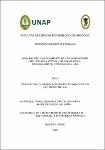| dc.contributor.advisor | Pinedo Manzur, Freddy Martín | |
| dc.contributor.advisor | Meza Sánchez, Graciela Rocío | |
| dc.contributor.author | Díaz Villacorta, Raúl Segundo | |
| dc.contributor.author | Escobedo Saldaña, Jairo | |
| dc.date.accessioned | 2019-02-12T15:00:16Z | |
| dc.date.available | 2019-02-12T15:00:16Z | |
| dc.date.issued | 2018 | |
| dc.identifier.other | 353.69 D69 2018 | es_PE |
| dc.identifier.uri | http://repositorio.unapiquitos.edu.pe/handle/20.500.12737/5767 | |
| dc.description.abstract | Existe una gran parte de la población que vive en la condición de pobreza o pobreza extrema y que, debido a ello, no tiene acceso a la salud pública. Para suplir esta deficiencia, el Estado creó el Seguro Integral de Salud (SIS) como parte de los programas sociales para atender a las poblaciones vulnerables, buscando darles el servicio de salud en forma íntegra (atención, diagnóstico, tratamiento, etc.). Además, trabaja algunos indicadores de salud preventiva e involucramiento de los escolares. El objetivo de la presente investigación es analizar el cumplimiento de los indicadores del Seguro Integral de Salud (SIS) de la región Loreto, en el periodo 2013 – 2016. Para ello, se llevó a cabo la presente investigación de tipo Descriptivo y de diseño No Experimental, analizando el comportamiento de los indicadores sanitarios y no sanitarios. Además, se analiza año a año el comportamiento del “Gasto Por Reposición” que asciende a S/ 52,998,600.00; el mismo que tuvo un desenvolvimiento variable durante la serie en estudio. El “Gasto Por Gestión” fue mayor y llegó a S/ 75,444,625.00; también con un comportamiento marcado por los incrementos y descensos. Las metas de los indicadores no se cumplieron faltando atender en 11.65%, pues los resultados obtenidos fueron de 3,413,373 atenciones y las metas eran de 3,863,474. Cabe precisar que los “Indicadores Sanitarios” constituyen el 99.77% (3,405,617 atenciones) de los indicadores totales, y los “Indicadores No Sanitarios” solamente el 0.23% (7,756 atenciones). Por otro lado, se debe destacar la importancia que le da el Sistema Integral de Salud al trabajo de medicina preventiva, ya que ello hará que se gaste menos en medicina recuperativa. | es_PE |
| dc.description.abstract | There is a large part of the population that lives in the condition of poverty or extreme poverty and, because of this, has no access to public health. In order to overcome this deficiency, the State created Comprehensive Health Insurance (SIS) as part of social programs to care for vulnerable populations, seeking to provide them with comprehensive health care (care, diagnosis, treatment, etc.). In addition, it works some indicators of preventive health and involvement of schoolchildren. The objective of the present investigation is to analyze the compliance of the indicators of the Comprehensive Health Insurance (SIS) of the region Loreto, during the period 2013 - 2016. For this, the present investigation of the Descriptive and of the design type No Experimental, analyzing the behavior of sanitary and non-sanitary indicators. In addition, the behavior of the "Replacement Expense" amounting to S/ 52,998,600.00, is analyzed every year; the same one that had a variable development during the series under study. The "Spending for Management" was higher and reached S/ 75,444,625.00; also with a behavior marked by increases and decreases. The goals of the indicators were not met without attending 11.65%, since the results obtained were 3,413,373 attentions and the goals were 3,863,474. It should be noted that the "Sanitary Indicators" constitute 99.77% (3,405,617 attentions) of the total indicators, and the "Non-Sanitary Indicators" only 0.23% (7,756 attentions). On the other hand, it is necessary to emphasize the importance that the Integral Health System gives to the work of preventive medicine, since this will cause that it spends less in recuperative medicine. | en_US |
| dc.description.uri | Tesis | es_PE |
| dc.format | application/pdf | es_PE |
| dc.language.iso | spa | es_PE |
| dc.publisher | Universidad Nacional de la Amazonía Peruana | es_PE |
| dc.rights | info:eu-repo/semantics/openAccess | es_PE |
| dc.rights | Attribution 3.0 United States | * |
| dc.rights.uri | http://creativecommons.org/licenses/by/3.0/us/ | * |
| dc.source | Universidad Nacional de la Amazonía Peruana | es_PE |
| dc.source | Repositorio institucional - UNAP | es_PE |
| dc.subject | Seguro de salud | es_PE |
| dc.subject | Indicadores de salud | es_PE |
| dc.subject | Cumplimiento de las directivas anticipadas | es_PE |
| dc.title | Análisis del Cumplimiento de los Indicadores del Seguro Integral de Salud de la Región Loreto, Periodo 2013 - 2016 | es_PE |
| dc.type | info:eu-repo/semantics/masterThesis | es_PE |
| thesis.degree.discipline | Ciencias Económicas y de Negocios | es_PE |
| thesis.degree.grantor | Universidad Nacional de la Amazonía Peruana. Escuela de Posgrado | es_PE |
| thesis.degree.level | Maestría | es_PE |
| thesis.degree.name | Magister en Gestión Pública | es_PE |
| thesis.degree.program | Regular | es_PE |
| dc.subject.ocde | Administración Pública | es_PE |
| dc.subject.ocde | http://purl.org/pe-repo/ocde/ford#5.06.02 | es_PE |


